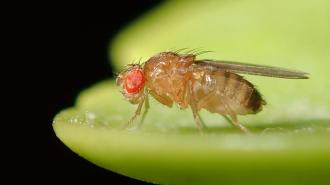If you’re a fruit fly, the mere sight of dead fruit flies will hasten your own demise. Scientists have found that exposing flies for 48 hours to the corpses of other flies that died of starvation reduces their lifespan from around 60 days to 45 days.
Reporting their findings in the journal PLOS Biology, the researchers suggest that the sight of dead individuals of their own species might evoke a “depressive-like” state in the flies that accelerates aging.
Scientists have found that exposing flies to the corpses of other flies reduces their lifespan from around 60 to 45 days.
Interestingly, the sight of flies that had frozen to death had no effect on lifespan, perhaps suggesting that the insects can somehow detect how other flies have died, and that signs of starvation are uniquely distressing for them.
The scientists have traced this sensory death response to a part of the fly’s brain called the ellipsoid body, which controls motor coordination and sensory integration. Two types of neuron, R2 and R4, work together like a dimmer switch to speed up or slow down the rate at which the flies age in response to what they’ve seen.
Studies of model organisms have revealed other direct links between the senses and aging. Genetic mutations that affect the activity of sensory neurons in the nematode worm C. elegans, for example, can cut short or extend its life, and fruit flies that have been genetically engineered to have no sense of smell live longer.
The sight of dead individuals of their own species might evoke a “depressive-like” state in the flies that accelerates aging.
Pain can also reduce longevity in some animals. Scientists have found that mice lacking a particular pain receptor live longer, healthier lives.
Christi Gendron of the University of Michigan at Ann Arbor, who led the research into the death response in flies, thinks there may be an evolutionarily conserved mechanism that links perception and aging across species.
“The specific cues that lead to changes in the life spans of worms, flies and mice are likely species-specific,” she writes in The Conversation. “But the fact that they are all affected by changes in sensory input suggests that the molecular mechanisms driving age-related changes may be shared by all, including people.”
Understanding the molecular machinery that links perception to aging may suggest possible ways to short-circuit it. The researchers believe this might be particularly beneficial in cases of post-traumatic stress.
“While translating these findings to humans is clearly speculative, we hope that more research can eventually help researchers better understand the physiological and psychological effects of people who routinely witness death, such as soldiers and first responders,” writes Gendron.
Perception of death is known to affect behavior, physiology, and longevity in a broad range of animal species, possibly as a result of the clues that corpses provide about threats to survival, including disease and lack of resources, such as food and water.
Social insects like honey bees and ants, for example, remove dead colony members from their nests to minimize the risk of infection, and the smell of dead zebrafish provokes defensive behavior in living zebrafish.
Mammals, from elephants and cetaceans to chimpanzees, also behave in distinctive ways toward their dead. Needless to say, death can have profound consequences for the psychological wellbeing of humans, but it can also have effects on physical health, including headaches, fatigue, and worsening cardiovascular disease.
Understanding the molecular machinery that links perception to aging may suggest possible ways to short-circuit it.
The new research in fruit flies adds to a large body of evidence that the aging process evolved, rather than simply being the result of the random accumulation of damage to cells and molecules over time. Crucially, this would mean that aging is modifiable.
According to the disposable soma hypothesis, organisms have evolved as individuals to strike a balance between the energy they devote to reproduction, on the one hand, and molecular repairs on the other, depending on the availability of resources such as food.
More recent evolutionary theories of aging propose that aging is actually programmed to occur faster during times of danger or scarcity, because this may benefit the population as a whole. According to this perspective, the flies that age faster when they encounter the corpses of others that starved to death would be “taking one for the team” (or perhaps for close relatives).
Regardless of how the sensory death response evolved in flies, it has a curious parallel with how the human brain responds to extreme adversity.
In flies, a particular type of serotonin receptor, in the membranes of R2 and R4 neurons, transmits the signal that accelerates aging when they see flies that have died of starvation.
“While translating these findings to humans is clearly speculative, we hope that more research can eventually help researchers better understand the physiological and psychological effects of people who routinely witness death, such as soldiers and first responders.”
Christi Gendron
The receptor, called the serotonin 2A or 5-HT2A receptor, is also found in the cortex of the human brain. According to one hypothesis, this receptor’s evolutionary role may be to promote a burst of neural “plasticity” (or flexibility) that might help an organism to adapt its behavior in times of extreme adversity.
The idea is that highly stressful conditions, such as starvation or asphyxia, cause a massive release of serotonin in the brain and a burst of serotonin 2A signaling.Recently, the same receptor has gained notoriety as the mediator of the hallucinogenic effects of psychedelic drugs. This may explain why extreme adversity can also trigger altered states of consciousness, including near death experiences.
We’d love to hear from you! If you have a comment about this article or if you have a tip for a future Freethink story, please email us at tips@freethink.com.
